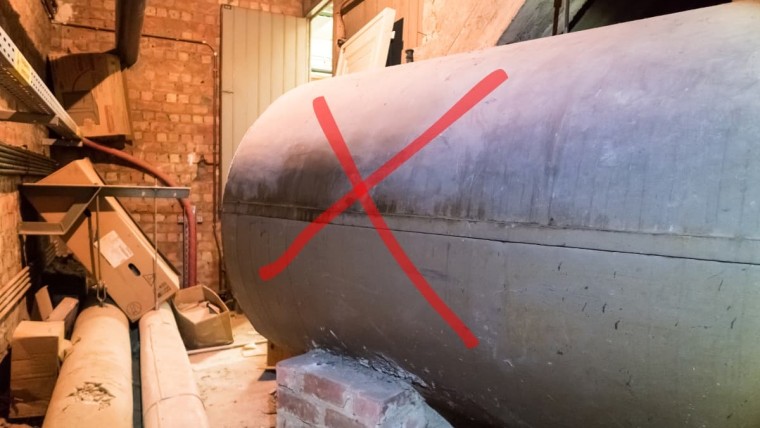Risks associated with an empty oil tank
An empty oil tank, while seemingly harmless, can lead to several problems:
- Condensation : When the fuel runs out, the inside of the tank becomes colder than the surrounding air.
- Corrosion : When the tank is empty, the oxygen in the air can cause the metal in the tank to rust.
- Gas formation : An empty tank can also accumulate flammable gases, such as hydrogen sulfide. In addition, some remaining fuel residues may undergo chemical reactions, potentially releasing gaseous compounds harmful to the environment.
Health and environmental risks
The management of empty oil tanks represents a major health and environmental safety issue, particularly in the event of leakage or tank failure. Emissions from empty oil tanks are one of the greatest health risks.
In addition to the health risks, emissions from an empty oil tank can contaminate soil and groundwater, and compromise the quality of natural resources. That's why it's imperative to implement appropriate preventive measures, as well as clean-up and decontamination procedures, by calling in a company specialized in oil tank removal. Here are a few practical tips for avoiding risks:
- Regular inspections : have your tank checked to ensure that everything is in order and that there are no leaks or anomalies.
- Professional experts : an empty oil tank should be managed by professionals, because of their expertise, equipment, compliance with regulations and ability to ensure complete, efficient management throughout the removal process.
- Prevention is better than cure: have the empty oil tank removed before it becomes a problem.
Legislation and regulations
The management of empty fuel oil tanks is subject to important rules to guarantee safety and environmental protection. The law stipulates that any permanent abandonment of a tank must be subject to measures designed to prevent any risk of vapour formation: emptying, degassing, cleaning, filling or complete removal.
As we have seen, an empty fuel oil tank is a danger to humans and the environment, and cannot be kept, whether completely empty or partially empty.
Other laws such as these have set specific standards for environmental protection, including the removal of empty oil tanks. Under these regulations, owners are required to have empty oil tanks removed in a compliant manner.
Safe removal 100% of empty oil tanks
Calling on an oil tank removal company
When you opt for a more modern, environmentally-friendly heating system, such as a heat pump or gas-fired boiler, the old oil tank becomes obsolete. Removing this tank is a crucial step to avoid environmental risks and ensure safety.
Disposing of a fuel oil tank is not without risk, especially if small residues of oil remain in the tank. These residues can lead to soil pollution in the event of a leak. What's more, oil vapors remaining in the tank present an explosion risk if they come into contact with a source of ignition.
That's why it's imperative to call in a specialist company to drain, clean and degas the tank. These steps eliminate flammable vapors and fuel residues, reducing the risk of environmental contamination and explosion.
Oil tank explosion: Causes
Oil tank explosions, although rare, can occur and are generally due to an accumulation of flammable vapors inside the tank. When a fuel oil tank is in use, it contains both liquid fuel oil and fuel oil vapors.
If a tank is poorly maintained or damaged, these vapors can accumulate and form an explosive mixture with the surrounding air. The risk of explosion is particularly high when a tank is empty or nearly empty, as the empty space is then filled with these vapors. A source of ignition, such as a spark, faulty electrical equipment, or even a cigarette, can ignite these vapors, leading to an explosion.
In addition, corrosion or leaks in an old tank can also increase the risk of vapors being exposed to ignition sources. Therefore, regular maintenance and safe removal of unused oil tanks by professionals are essential to prevent such incidents.
Unused oil tank: solutions
Once the tank has been properly cleaned and degassed, you have several options for determining its future use. If it's an old underground oil tank and there are no construction projects on the site, the simplest solution is to fill it with an inert material such as sand or concrete.
If the oil tank is buried, the process is a little more delicate and may require cutting the tank out. By treating and insulating the tank, installing an anti-turbulence device and a pump, it is possible to transform your old oil tank into a water collector.
An old oil tank represents a real danger to the environment and human health, so it must be properly removed in accordance with regulations. Article 28 of the July 1, 2004 decree governs this particular situation: "Any permanent abandonment of a tank must be subject to measures designed to avoid any risk of vapour formation: emptying, degassing and cleaning; filling or removal of said tank".
This article clearly stipulates that the tank must be emptied, degassed and cleaned. An abandoned tank can emit gas fumes, while its corrosion can also lead to leaks seeping into the ground - a real environmental hazard.
Leaving it in its current state is not an option. Given the risks of explosion and environmental pollution, it is strongly recommended that expert advice be sought on the appropriate treatment and removal of tanks.

Julien G.
Juliena mechanical engineering graduate and specialist in climate engineering since 2009, has become a writer specializing in renewable energies, with expertise in heat pumps and photovoltaic solar panels for individual housing.
See all articles by this author






